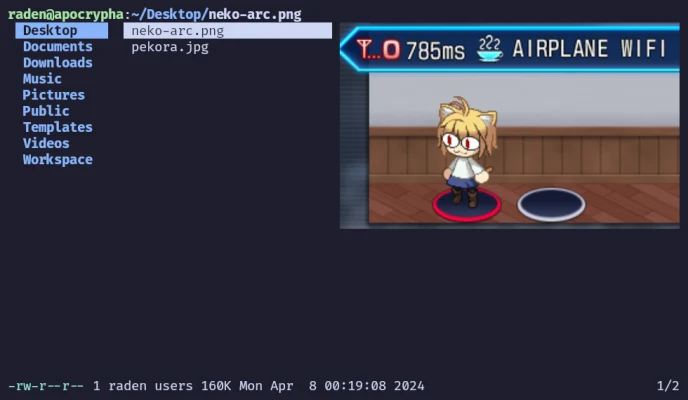
Terminal-based file managers
Organizing your files like a nerd
Terminal-based file managers offer numerous practical use cases. They are particularly valuable for users who prefer to work entirely within the terminal, eliminating the need to switch to a GUI application just to browse a file tree or preview some files.
They are also part of the minimal install linux rice subculture. When I first started with Arch Linux, URXVT (rxvt-unicode) was the go-to terminal emulator, Many users customized their setups with tools like pywal to synchronize colors across their desktops at the same time, Ranger was the most popular file manager.
Although pywal has since been archived and URXVT has largely fallen out of use, several new terminal-based file managers have emerged that I'd like to discuss.
lf (as in "list files")
The main reason for choosing lf over other tools is its simplicity. It comes with Vim keybindings by default and allows users to extend its functionality through custom scripts.
lf searches for the configuration file in the user's config directory at
$XDG_CONFIG_DIRS/lf/lfrc. However, you can specify a different location
using the -config flag.
set shell fish
set shellopts '-eu'
# leave some space at the top and the bottom of the screen
set scrolloff 10
# make sure trash folder exists
%mkdir -p ~/.local/share/Trash/files
# move current file or selected files to trash folder
cmd trash %set -f; mv $fx ~/.local/share/Trash/files
# compress current file or selected files with zip
cmd zip ${{
set -f
mkdir $1
cp -r $fx $1
zip -r $1.zip $1
rm -rf $1
}}The example file can be found in /usr/share/doc/lf/lfrc.example or the GitHub
repository.
File Preview
To write the previewer script, ensure you understand the five arguments passed to it:
- File: $1 (file path)
- Width: $2 (previewer's width)
- Height: $3 (previewer's height)
- Left: $4 (margion of the previewer from left)
- Top: $5 (margion of the previewer from top)
Additionally, you can run lf with the -debug flag to generate a log
file, which can be helpful for troubleshooting purposes.
lf -log /tmp/lf_logSome files may require thumbnails. For more details, consider reviewing the freedesktop specification
For images and cover my recommendation is to use the kitty graphics protocol.
#!/usr/bin/env fish
set thumbnail (printf "$XDG_CACHE_HOME/thumbnails/large/%s.png" (echo -n "file://$argv[1]"| md5sum| awk '{print $1}'))
mkdir -p $XDG_CACHE_HOME/thumbnails/large/
function preview_image
kitty +kitten icat --stdin no --transfer-mode file --place \
{$argv[2]}x{$argv[3]}@{$argv[4]}x{$argv[5]} $argv[1] >/dev/tty
exit 1
end
switch (file --dereference --brief --mime-type $argv[1])
case "application/x-tar"
tar tf $argv[1]
case "application/zip"
unzip -l $argv[1]
case "audio/flac"
if test ! -f $thumbnail; metaflac --export-picture-to=$thumbnail $argv[1]; end
preview_image $thumbnail $argv[2] $argv[3] $argv[4] $argv[5]
case "video/*"
if test ! -f $thumbnail; ffmpeg -i $argv[1] -vframes 1 $thumbnail; end
preview_image $thumbnail $argv[2] $argv[3] $argv[4] $argv[5]
case "image/*"
preview_image $argv
case "*"
bat -p -f $argv[1]
endYazi
Yazi is by far the most well-documented option. It features comprehensive documentation, numerous YouTube videos—even beyond the Linux community—and various plugins to help users understand how to create their own.
To install a Flavor which is a pre-made theme, yazi comes with a
package manager.
# Installing catppuccin-mocha.yazi
ya pack -a yazi-rs/flavors:catppuccin-mocha[flavor]
use = "catppuccin-mocha"You can also clone the directory using Git, but the package manager is capable of updating all plugins and flavors at once.
ya pack -uBe sure to back up the packages.toml file in your dotfiles. This ensures Yazi can reinstall and update your plugins seamlessly.
Yazi can preview most common file types, but for others, you'll need to install a plugin. This process is a bit more challenging compared to lf because Yazi uses Lua instead of shell scripts. However, there are already many plugins you can install.
Conclusion
I find Yazi more enjoyable and faster to use than lf, although there are a few considerations to keep in mind.
Since Yazi is designed to implement multiple protocols, you can't take full advantage of Kitty's features. Additionally, Yazi generates optimized versions of images at lower quality to help with performance, but this doesn't mean that implementing similar optimizations in lf would be slow; the quality loss is noticeable.
Currently, the version in Nixpkgs does not support alpha channels for PNGs, and I'm unsure if animation support will ever be implemented.
On the bright side, Yazi is under active development, and if you run the latest commit, the PNG images caching has been fixed:
nix registry add yazi github:sxyazi/yazi
nix profile install yaziFor now, I prefer using Yazi, as it generally works better within tmux.